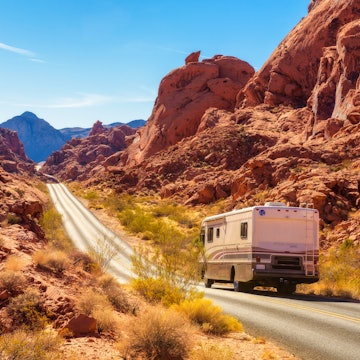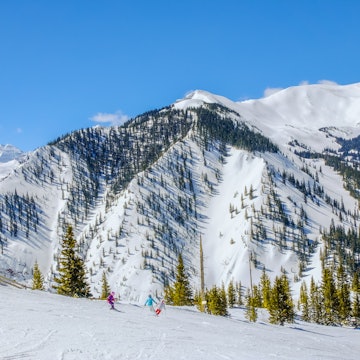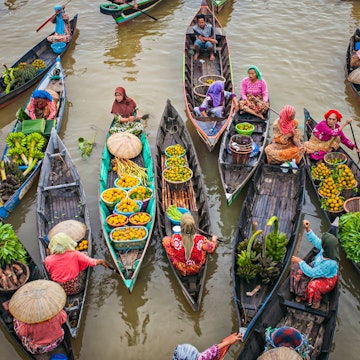
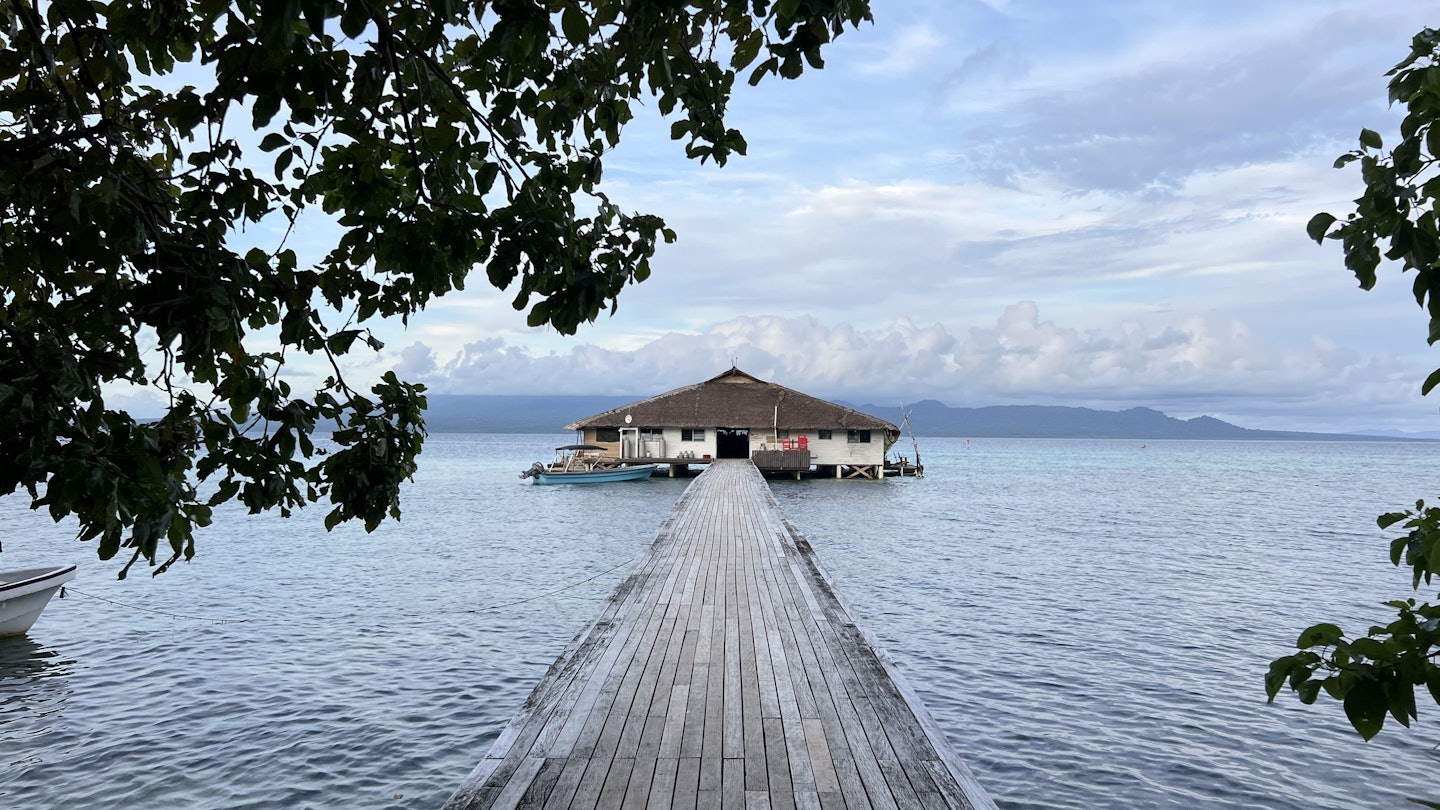
The overwater restaurant at Fatboys Resort, near Gizo. Jessica Lockhart/Lonely Planet
The Solomon Islands may be just a three-hour direct flight from Brisbane, yet few people – save for divers, birders and WWII history enthusiasts – seem to know about it. Situated between Papua New Guinea and Vanuatu, only 26,000 visit the island archipelago every year. But those who do will make sure you know about it.
After my first visit in late 2024, I fit firmly into this category. If you’ve talked to me recently, you’ve heard me rave about the abundant marine life, the incredible culture (there are more than 70 languages spoken!) and how surprisingly easy this country is to explore.
Sure, you might not find opulent resorts with swim-up bars and kids’ clubs, but it’s still possible to while away your days swinging from a hammock and splashing in the sea.
But for those of us (read: me) who aren’t particularly good at doing nothing at all, I’m pleased to declare the Solomon Islands may be the South Pacific’s next great adventure outpost. In the "Hapi Isles," it's possible to surf, dive and snorkel above pristine reef systems, hike through some of the most biodiverse rainforest on the planet and learn more about the rich Melanesian cultural traditions – all in as little as one week.
Dreaming of your own Solomon Islands getaway? This weeklong itinerary will see you exploring the gritty capital city of Honiara and island-hopping your way through the postcard-perfect tropics of the Western Province.

When to arrive
This is a year-round destination. But when it comes to exact arrival times, you’re not exactly spoilt for choice. Only four direct flights arrive per week from Brisbane, Australia, with another three flights coming from Nadi, Fiji (the region’s main hub, with connections to Tokyo, Singapore, San Francisco, Los Angeles and Vancouver). Nearly all land in Honiara between 5pm and 8:30pm. Choose a hotel with an on-site restaurant to make life easy once you land.
How to get from the airport
Honiara International Airport is just 12km (7.5 miles) from most major hotels in the capital city’s center, but the short distance can take more than 30 minutes during rush hour. Many hotels offer airport pickup, but taxis (about SI$120/US$14) and private transfers (from SI$280/US$33) are also available from operators such as Hapi Isles Tours & Transfers.
If you do decide to book a transfer or tour for your time in Honiara, use Facebook or email to coordinate your visit. Like many businesses in the Solomon Islands, tour operators are unlikely to have a dedicated website or online booking engine.

Getting around
With 992 islands to explore, don’t limit yourself to Guadalcanal (one of the six main islands, where Honiara sits). Island hopping – especially to the sun-soaked shores of the Western Province, known for its sublime snorkeling and diving – is relatively easy:
Domestic flights: Solomon Airlines services more than 20 destinations, including Munda and Gizo in the Western Province. Flying is the quickest way to get around, but it can be less than reliable – delays are common. If possible, book buffer days into your itinerary for potential flight cancellations.
Banana boat: For shorter distances, these open-air vessels are a veritable pleasure cruise on fair-weather days. You’ll zoom past coral cays through unbelievably blue waters, while flying fish race alongside your boat. However, the colorful boats can be decidedly less pleasant in rough surf or heavy rain. Expect to pay about SI$1500 (US$176) per day for a charter.

What to pack
A backpack: The kind of bag you bring is just as important as its contents. For domestic flights, pack light; checked luggage is limited to 16kg (35lb). Backpacks – lined with a garbage bag to keep everything inside dry – are easier than hard-shelled suitcases to lug on and off banana boats.
Clothing that covers your head, shoulders, knees and toes: The Solomons don’t get nearly as many tourists as neighboring Fiji or Vanuatu, but most locals still won’t balk at the sight of your bare thighs, especially in beachside settings. The exception is in traditional villages, where it’s respectful to wear a shirt that covers your shoulders and long pants or a skirt. Your longs will do double-duty in the evenings when the mosquitos come out to play. (Talk to your travel doctor about anti-malarial medication.) Pack a hat to keep the sun off your face while travelling by banana boat and a pair of trail shoes or hiking boots for adventures in the interior.
Snorkeling gear: Some accommodations will have gear that you can borrow, but it may be worse for the wear and size selection can be limited. If you’re a serious snorkeler, bring your own mask and fins. (Bonus: if it starts pouring while you’re traveling by banana boat, you can strap on your mask to get through the deluge.) A rash guard or swim shirt will help protect you from the strong sun.
Walking poles: Hiking trails in the Solomon Islands are typically rugged and may not be well trafficked or maintained. If you plan on heading into the highlands, take a set of sticks to steady yourself on.
Cash: Wi-fi is more widespread than you might think (you can thank Starlink for that development), but this is still largely a cash-driven destination. Outside of the major hotels in Honiara, debit and credit cards are useless here.
A good book and a deck of cards: Little runs on schedule in the Solomon Islands. With cell phone reception all but nonexistent in many areas, you can’t rely on a solid scroll to pass the time. Instead, make sure you’re armed with a good book, a deck of cards or a true appreciation for staring off into the yonder.

Where to stay
In Honiara, it’s possible to check-in to a flashy hotel with air-conditioning, swimming pools and restaurants. Elsewhere, accommodation ranges from basic motel-style units to resort-like – but still relatively rustic – overwater bungalows. A few of our favorites in Honiara and the Western Province include:
Heritage Park Hotel: Centrally located, this is one of Honiara’s bougiest retreats, beloved by expats and locals alike for its waterfront swimming pool and bar. Multiple restaurants and a small gym round out the offerings.
Fatboys Resort: Situated in the Western Province – just a short boat ride from Gizo Town – this is the ultimate spot to flop and drop. Spend your morning snorkeling directly off the side of the overwater restaurant, your afternoon hitting up some of the finest surf breaks in the South Pacific, then round out your day drinking sundowners from the deck of your overwater bungalow. Rooms vary in size and amenities; if air-conditioning sits high on your wish list, double-check that it’s included.
Imbu Rano Lodge: Nestled high in the highlands of Kolombangara Island, this wilderness lodge is favored by visiting scientists and birdwatchers for its sweeping views of the surrounding cloud forest and extinct volcano craters. An outpost for outdoor adventures including hiking, “wilderness” is the key word here. There is no connectivity, little electricity and shared toilets are in a basic concrete block beside the main building. But who needs frills when the surrounds are this good?

Day 1: Explore the Solomons Islands’ capital city
Morning: To avoid the heat of the afternoon, head out early on your first full day. It’ll only take about three hours to hit up Honiara’s highlights, either by foot or as part of a dedicated tour.
First, survey the produce at Honiara’s Central Market. The stalls spread out into the parking lot, selling everything from fresh fish and ngali nuts (a local favorite, they give macadamias a run for its money) to secondhand clothing. Keep an eye out for multicolored necklaces strung with shells – this is “shell money,” the traditional currency of the Solomon Islands, which is prized and remains in use today.

Then, take a spin through the nearby Crafts Market for intricately carved wooden souvenirs, before dedicating about 45 minutes to exploring the Solomon Islands National Museum. Finish your tour at the American War Memorial, where the battles of Guadalcanal are inscribed on large stone tablets. WWII history not your thing? It’s still worth the trip for the memorial’s vantage point high on Skyline Ridge, with the entire city spread out below.
Afternoon: If you’d prefer a full-day tour, ask your guide to add on an excursion to Mbonege Beach, about 35 minutes northwest of Honiara. There, you’ll find the Kinugawa Maru, a WWII shipwreck that sits in water shallow enough to wade out. Bring snorkel gear and cash to cover the beach user fees. (Costs can vary, but expect to pay around SI$30/US$3.53 per person.) Afterward, enjoy a seaside sunset meal in the Heritage Park Hotel’s waterfront pool area.
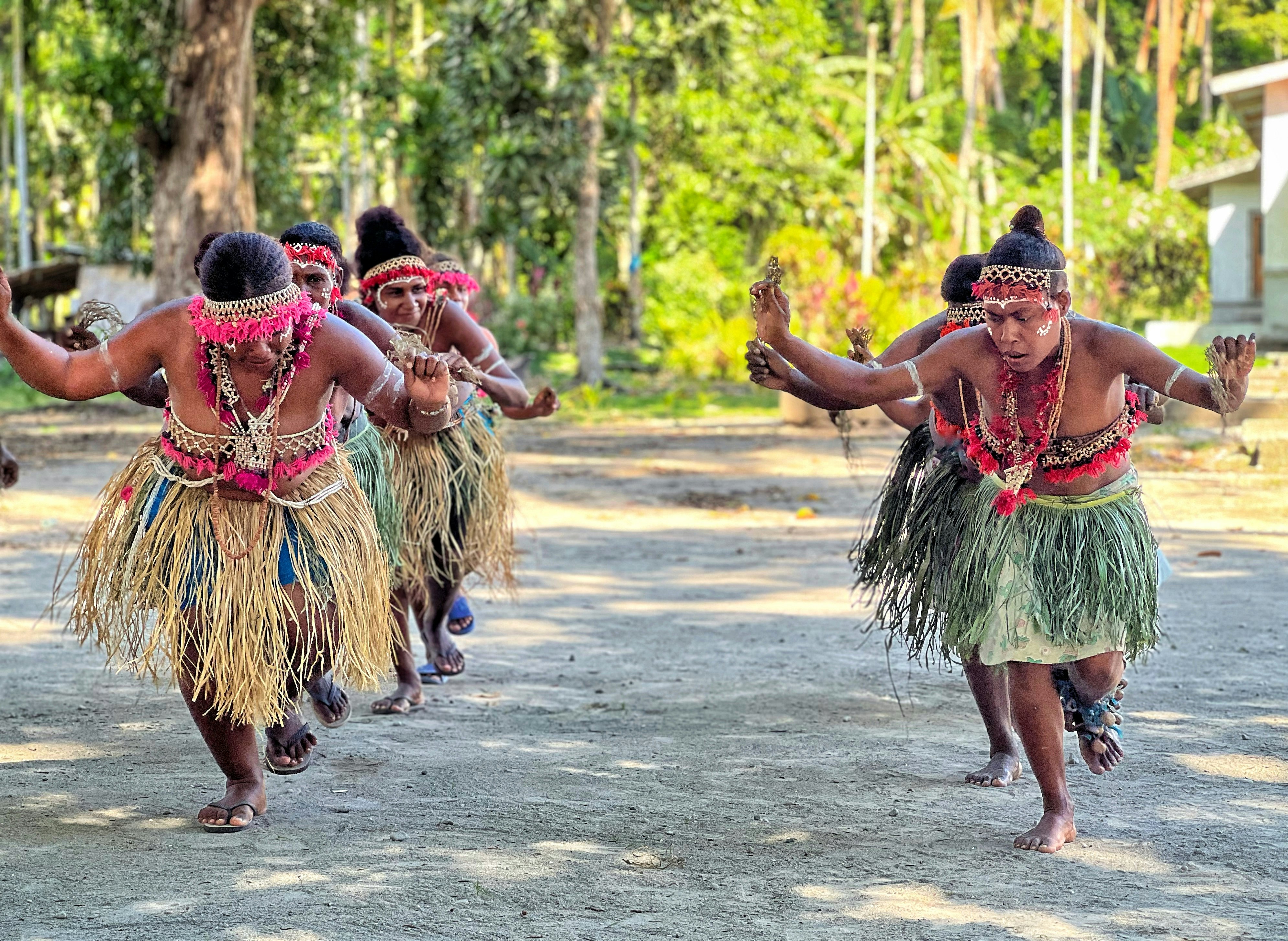
Day 2: Visit a traditional village and geothermal wonders on a day trip to Savo Island
Morning: Savo Island is only about an hour-long banana boat ride across the Iron Bottom Sound (so named for the dozens of ships and planes that sank there during WWII) from Honiara. But with its enduring cultural traditions, this volcanic outpost feels a world away.
Coordinate your visit through Savo Sunset Lodge, who can help arrange for a cultural performance in neighboring Kuila village. While English is the country’s official language and most islanders speak a relatively easy-to-understand Pijin, the villagers speak Savosavo, an endangered Papuan language.
Afternoon: Strap on your boots – it’s time to hike with a local guide upwards through Savo’s dense rainforest. You have two options: A 30-minute journey to a geothermally heated waterfall and hot spring, which is said to heal ailments. Or, if you’re feeling brave, it only takes four hours to trek into Savo Volcano’s crater, where you’ll witness gurgling geysers and steaming fumarole fields.

Day 3: Escape to Munda, your gateway to the Western Province
Morning: Catch the earliest flight from Honiara to Munda, your first stop in the Western Province. Make sure you get a window seat for the 50-minute flight – soaring above the white-sand beaches and extensive reef systems will give you a solid idea of why this area is renowned for its fishing, snorkeling and diving.
Upon arrival, grab something to eat from the Agnes Gateway Hotel’s overwater restaurant, before checking-in with the on-site tour operator, Go West Tours. It will transport you by banana boat across the scenic Vona Vona Lagoon to Skull Island.

On this shrine-like island, skulls of chiefs and their conquests from the head-hunting past are surrounded by ceremonial items, including examples of shell money and conch shells once used to summon villagers. A sacred site, the island can only be accessed with a local guide, who may undertake kastom (custom) proceedings to ensure its spirits welcome visitors.
Afternoon: Hop back in the banana boat to travel past white-sand beaches and palm-fringed islands and onwards to Kolombangara Island. Take time to soak in the scene of electric blues and greens, where volcanic cones dusted by clouds rise in the distance and massive schools of fish dance below.
Upon arrival at Ringi Cove, you’ll be collected by a 4WD, which will carry you through a massive forestry plantation and high into untouched cloud forest. Sitting at an elevation of 400m (1312ft), this is Imbu Rano Lodge, your accommodation for the night. Rooms are basic and there’s no connection to the outside world here; all there is to do is watch mist drift past the island’s volcanic craters and lush rainforest and the day fade into night.

Day 4: Hike deep into Kolombangara Island’s cloud forest
Morning: As you drink your morning coffee and watch the pink glow of dawn illuminate the day, keep your eyes peeled for the area’s rare and endemic bat, butterfly and bird species – including mountain pygmy parrots – flying past.
Fuel up for the lodge’s most popular guided hike to Myles Falls. It’s possible to swim at the base of these soaring twin falls, but you’ll be wet before you even get there – the four-hour round-trip walk involves a steep descent into the Vila River valley and dozens of river crossings. (Wear trail shoes or boots that you’re happy to get wet.) Along the way, your guides will point out ancient, terraced gardens. These are evidence of a time from the head-hunting past, when islanders lived in the dense rainforest to protect themselves from enemies rather than exposed along the coastlines, where most people live today.
Afternoon: After returning to the lodge to shower and pack up, catch your 4WD transfer followed by banana boat onwards to the Gizo area. While there are countless resorts to choose from, Fatboys Resort on tiny Mbambanga Island is a favorite, thanks to its overwater restaurant and bungalows.

Days 5 and 6: Snorkel, dive and surf in the waters around Gizo
For the next two days, it’s a matter of choosing your own adventure, with a long list of water-based activities available.
Most come to the Western Province for its wreck diving, with Gizo Town-based outfitter Dive Gizo guiding trips to many of the area’s countless WWII planes and shipwrecks. But the waters here also boast some of the richest concentrations of fish and highest marine biodiversity on the planet, alongside incredible visibility. You don’t even need to get in the water to see the coral gardens and fish below – the water is that clear. But don’t miss the chance to strap on a snorkel mask to explore sites such as Grand Central Station, off the northwestern tip of Njari Island. A merging point for oceanic currents, larger marine life – including sharks and trevally – can be found in the waters below.
Diving may be what put the Western Province on the map, but I’m calling it now – this is also the South Pacific’s next great surf destination. It’s got all the right elements, including uncrowded waves and consistent left- and right-hand breaks. The surf here is so good that the Australian surfers I met begged me not to write about it. (Sorry, mates; it’s a secret too good not to share.) The scene is still relatively nascent, so bring your own board and wetsuit if you’re keen to give it a crack.

For those looking for something to do on dry land – other than soaking in the sun and watching the aquamarine waters lap at the shore – try a wander through Gizo Town’s market. This provides another chance to sample local produce, like rose apples – a refreshing treat that’s reminiscent of biting into a crisp watermelon.
Day 7: Wave goodbye to the Hapi Isles
On your final day in the Solomon Islands, catch a flight from Gizo back to Honiara, where you can connect onwards to your next destination. Wave goodbye to the Hapi Isles and start planning your next holiday back. You’ve visited only eight of the country’s islands – meaning there are still 984 more to explore.
Jessica Lockhart visited the Solomon Islands at the invitation of Tourism Solomons. Lonely Planet does not accept freebies for positive coverage.







